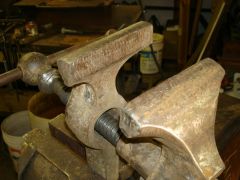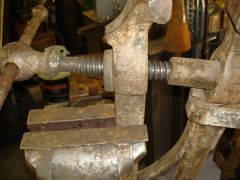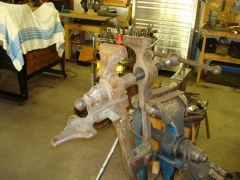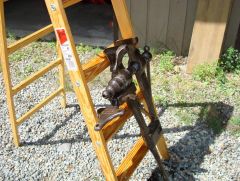-
Posts
745 -
Joined
-
Last visited
Content Type
Profiles
Forums
Articles
Gallery
Downloads
Events
Everything posted by petere76
-
Mojo, Philadelphia Resins Corporation, Philadelphia PA. The product is called Chock Fast. We use this stuff to bed large horsepower(multi thousand) Marine diesel engines. Metal to metal under the most punishing of operating conditions. This is impressive stuff, I have never seen this material fail in service. A very versitile and tough product. It may work for your application. Good luck. Peter
-
Hey Glen, No not a bed but rather a small 1922 ish SB lathe I try and keep the dust off. It was another one of those tool finds that seem to make it back home and get a second life. Thanks for transfering the pics over for me. Peter
-
Gents, Recently came across (e-bay) an old post vice (5 inch) and it found a home in my shop. I was skeptical of the overall condition of a 100 year old item but after examing my new find I was pleased to find it in excellent condition. Nothwihtstanding the consmetics of the vice exterior, the mechanics appeared almost new; little if any wear on the threads and no visible fractures. I cleaned and scaled the working surfaces and dye checked the ususal suspects for any sign of pending fracture; none noted. It is certainly a good turn of events when a 100 year old tool finds a new a useful life. Included a few photos of the subject vice for your review. Peter
-
Gents, Safety 101... read the material data safety information. Almost everything in the manufactured world come with a printed data sheet. We go to great extents to know and understand the material constraints of the metals we work, why not do the same for the contents of unknow materials we are working on. In my business we are flooded with litigation because of hazardous materials handling issues. Even the more observent in my own group are tripped up on ISM audits by simply not adequatly identifying the hazards involved. A job risk analysis sounds complicated but really it is a simply process we do all the time. It is the applicaton of the the look before you leap mentality. Identify and understand the properties of everything involved in, or part of the process. Yes, residule contents or unknown coatings like zinc are part of the analysis. Anything involving vapors poses an immediate risk to personnle in the immediate area because of the efficeny of our respiratory system. The fastest way to get something into our bodies is actually through the lungs. We should all be guided accordingly. Peter
-

Can you make a living Blacksmithing?
petere76 replied to Drako11's topic in Blacksmithing, General Discussion
Drako, The world lies before you, enjoy the ride. The always pressing challenge making a living is the only obstacle to our pursuit of iron perfection. This said, one is best off with as much education as you can afford in the time allotted. Ironwork and the ironworker both have learning curves; it takes time to become accomplished and for your work to gain local favor. Even looking at a best case scenario, 5-7 years is the projected capitalization average for new start ups. This is steep number when you start looking for backers. You may be looking for a second job. Many Smiths have alternate careers and one pursuit supports the other. It's not the job you do for money it's the work you do for love. Keep this in mind when you find out the Blacksmith is a Lawyer or an Engineer. Good luck to ya, Peter -
Forged vs. fabricated. Hand Hammered vs. machine pressed. Both are moot points because it is the Smith (artist) that has the vision and defines the process to produce a piece. Nothwithstanding the addition of the multi axis CNC rig Unkle quoted, most smiths carry the vison from a thought to a product. Be it simple or complex the process is essentially identical although the time variable is proportionaly to the tasking. This is the heart of the process. Tools, material and craft skills are the mechanism. As is evidenced by the lively exchanges here on IFI, many a truth is truly said in jest, Sarcasism is one of our best means of information exchange and a good source of humor among friends. Peter
-
Mojo, Did a job in Nothern Jersey where we pulled old railing sections out of drilled fieldstone. We heated the bar close to the lead setting and shook the assembly. The lead loosens up and allows the bar to come free. I noted some of the bars at junctions were extrta deep set in the stone and they had a twist on the end to hold fast. We first tried to heat the stone area in hopes of melting off the lead but some of the stones fractured with the heat. Our method of choice on that particular job was heating the bar. As an alternative to lead setting consider using a poly based resin manufactured by the Philadelphia Resins Corporation. The prodcut name is "Chock-Fast". The product is ideal for harsh enviroment applications, it is not effected by temperature vibtration or moisture and it is reasonably priced. The cure time is depedent on the volume of the set but within 24 hours the product has sufficently hardened to be machined. Good luck, Peter
-

Do you use your forging hammer to hit a tool (punch ,drift etc.)????
petere76 replied to hammerkid's topic in Hand Hammers
I use junk hammers for striking set tooling. After a time the tooling mars (dents) the finish on the good forging hammers and the marks end up being transfered to the finished piece. I don't intentionally harden the driven end of any of my set tooling but even still, the tooling will occasionally mar the hammer faces, thus the use of the "junk" hammer saves the faces of my favorite forging hammers. I believe this is covered under the rule of " work smarter not harder". -
I got this idea from a set of plans I saw for a hot bending jig (re: blacksmiths journal). I turned a steel bushing at .62 OD bored for .375 ID at 2.0 LOA. This bushing allows the use of the set of NH bending dies supplied with their Chinese bench top bender. The dies are stout enough and they work well while mounted to the .5 IN drilled and tapped plate. The rig will vise mount or can be inserted in the Hardy. In use, I did note that the .375 IN fabricated sliding bracket could be heavier in dimension. Photos attached. Peter
-

Non-contact infrared thermometer
petere76 replied to Rosco's topic in Blacksmithing, General Discussion
The higher priced units are more reliable over time. The higher priced units can be lab calibrated whereas the lower proced units are generally not sent out to service centers for calibration. the cost of calibration is often greatert than the cost of replacement. In the field, most sample points for IR readings are predetermined (same place every time) and they are coated to be non-reflective. Reflective surfaces give erronious readings. In the higher Temp ranges (forging) the low price units are usualy well out of range. The IR hand held units are great for maintenance troubleshooting (hot spots) such as would be found on loose electrical feeder terminations, faulty line shaft bearings or insulation failures on uptakes or HVAC distribution systems. -

artemis wrought iron- hello all !!
petere76 replied to artemis's topic in Blacksmithing, General Discussion
Very nice gate sections. How about some information on your calculations for offset due to sag? Thanks and regards. Peter -
Cooper, Made a set hammer out of a GMC dump drive shaft; worked great. Heat, slit and drift as you would any hammer. Forge to the shape desired, file and dress. Aneal overnight. Again heat to critical (non-mag) and quench. Draw face to straw color and fully quench. Finish (polish) with flap disc. Grind ey opening edges and heft as you would a hammer or other set tooling. I went with a bent 3/8 round stock handle but any conventional hammer handle (wood) will work just fine. I'll try and get a pic up tomorrow. Peter
-
Mark, Nice job... quick easy, very well done. Peter
-
Gents, Unless you want a very large stamp head with a simple line design, the file and grind procedure will not give you all that good a product. I found that the time involved is very out balanced by the cost of just buying the premade unit. Also once the outfit has your logo in the computer you can always order new ones. Peter
-
Hofi, Please advise specs and details on the new anvils when you have time. Thanks, Peter
-
We make gongs out of 4 in and candle holders out of both 3/4 and 1 in. The gongs are torch cut and riveted to a round stock hanger. The sound is good. Unless you specificaly buy seamless pipe (expensive) it has a seam and it will fail at the seam if you dont keep rolling it during forging. Dablacksmith, I am curious on the bells.
-
Wagon master, Thanks for getting the pics, great stuff is where you find it. Glen, the next-previous switch is a great idea.
-
A lot of folks use corn in pellet stoves in this part of Maine. It burns hot, relatively clean and it produces a cliker of sorts from the carbonized sugar. Obviously the corn is dried. I am not certain what the burn rate would be for forging. Good luck. Peter
-
Nice work. On the basket, did they use the baskets for anything or is it just deocrative. I got the meat roasting part ok, not sure of the basket though. Peter
-

New (to me) anvils, one small one BIG!
petere76 replied to DKForge's topic in Anvils, Swage Blocks, and Mandrels
Good hunting there DK. Year is off to a fine start. Peter -
Exceptional sir, great job. I like the speak easy port. Well done.




